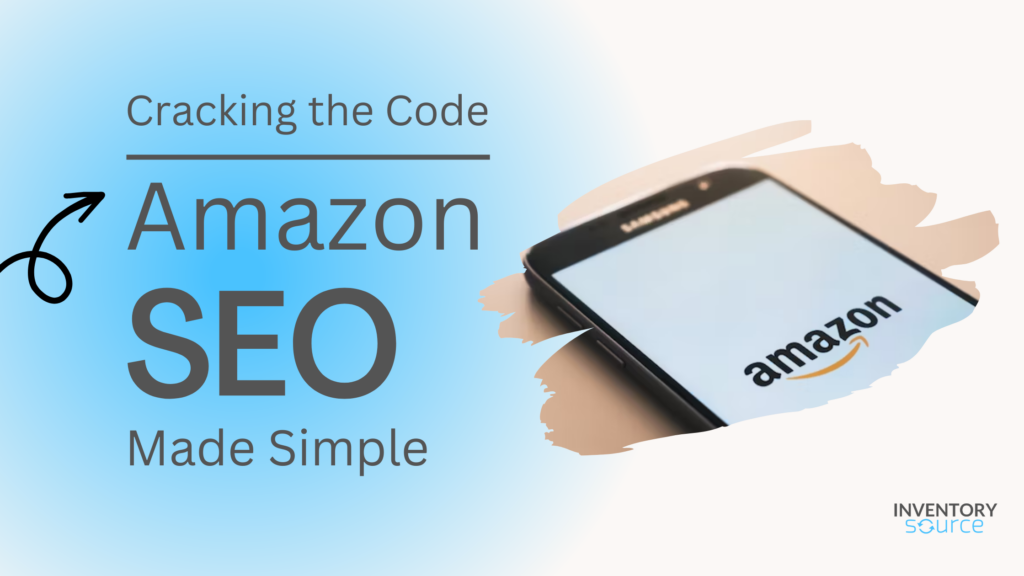Cracking the Code: Amazon SEO Made Simple
Welcome to the world of Amazon, where e-commerce dreams can come true. As an e-commerce business owner, you’re in for a ride. In this article, we’ll break down the mystery of Amazon SEO (Search Engine Optimization) into easy-to-understand steps, ensuring your products get the attention they deserve on the Amazon platform.
Understanding Amazon SEO
Let’s start from the beginning. What exactly is Amazon SEO, and why should you care?
What is Amazon SEO?
Amazon SEO, or Amazon Search Engine Optimization, refers to the practice of optimizing product listings on Amazon’s e-commerce platform to improve their visibility in search results. It’s similar to traditional SEO (Search Engine Optimization), but it’s tailored specifically to Amazon’s search algorithm and product listings.
The goal of Amazon SEO is to make your products more discoverable to potential customers when they search for products similar to what you’re selling on Amazon. By strategically using keywords, optimizing product titles, descriptions, and other listing elements, you can increase the chances of your products appearing at the top of Amazon’s search results.
In essence, Amazon SEO helps you stand out in the crowded marketplace, attract more organic (unpaid) traffic to your product listings, and ultimately drive more sales. It’s a crucial aspect of e-commerce success on Amazon, as higher visibility can lead to increased sales and business growth.
Why Amazon SEO Matters
Imagine you have a fantastic product, but it’s hidden in a big store where no one can see it. That’s where Amazon SEO comes to the rescue. When you do it right, your products will appear near the top when people search, which means more people will see and buy them. And that’s the name of the game!
Let’s Get Started: Amazon SEO Basics
Now, let’s roll up our sleeves and dive into the basics of Amazon SEO.
1. Keywords for Amazon Products
Keywords are like magic words that help customers find your products. Start by thinking about what words or phrases your customers might use to search for products like yours. Tools on Amazon or other websites can help you find these unique words.
There are other tools also available that can help you search the keywords around your products. Some of these can use Google Keywords Planner, SEMRush Keywords Magic Tool, Google Trends, etc. These tools help you to provide valuable insights into various aspects of keywords, such as search volume, competition level, and relevance.
2. Crafting Product Titles
Your product title is super important. It’s like the sign that tells people what’s inside. Make sure it’s clear and includes those special keywords we talked about earlier. Keep it short and sweet, but don’t forget to describe your product well.
Here are some common guidelines for Amazon product titles that you should keep in mind:
Accuracy Matters: Your product title should match what you see on the actual packaging of the product. Make sure it’s precise and reflects the item’s identity.
Mind the Length: Keep your title reasonably short, around 60 characters, and no more than 80 characters. Shorter titles are easier to read and grasp quickly, which is important for grabbing a customer’s attention.
Category-Specific Styles: Different product categories might have preferred title lengths and styles. Pay attention to these variations to optimize your listings effectively.
Proper Capitalization: Capitalize the first letter of each word in the title, except for small words like prepositions, conjunctions, and articles.
Brand Name First: Start your title with the product’s brand name and ensure the brand field is filled in correctly.
Numerals Are Friendly: Use numerals (like “2”) instead of written numbers (like “two”) for a clearer, more concise title.
No Special Characters: Avoid using non-language characters such as Æ, ©, or ® in your title.
Essential Information Only: Include only the necessary details in your title to identify the item. Leave out unnecessary information.
Stay Objective: Refrain from using subjective terms like “Hot Item” or “Best Seller” in the title.
Punctuation and Abbreviations: Use necessary punctuation like hyphens, slashes, commas, ampersands, and periods. You can also abbreviate measurements, like “cm” or “oz”.

3. Bullet Points: The Quick Pitch
Consider yourself in an elevator with a potential customer. If You only have a few seconds to convince them to buy your product. That’s what bullet points are for. Use them to share the best things about your product quickly. Don’t forget those keywords!
4. Product Descriptions: The Storytelling Part
This is where you can tell a bit more about your product. Use simple language and describe why your product is awesome. Remember to sprinkle those keywords naturally throughout the description.
You need to keep your product descriptions under 300 words. Also, Always keep Your Amazon Product listing descriptions simple. You don’t need to make it complicated. Clearly specify features, benefits, specifications, package inclusions, and any other detail that is important for customers to know.
To make your product descriptions stand out even more, consider these valuable pointers:
Highlight the Brand: Incorporate the brand name to reinforce product identity and build trust.
Size Details: Specify sizes when applicable, like shoe sizes for footwear products.
Material Insights: Share material information, such as mentioning canvas for a backpack, to provide clarity to potential buyers.
Relevant Specifics: Include relevant specifics like color options, packaging details, and quantity in each listing.
5. A+ Content (Enhanced Brand Content)
A+ Content, also known as Enhanced Brand Content, offers a fantastic opportunity for brand owners on Amazon. It allows you to elevate the presentation of your product listings, making them stand out and appear more appealing to potential customers.
With A+ Content, you can create visually captivating and informative content that goes beyond the standard product description. Here’s how you can leverage A+ Content to enhance your product listings:
Visually Engaging Content: A+ Content lets you use high-quality images, videos, and enhanced text formatting to create visually appealing product listings. This allows you to showcase your products in a more engaging and attractive way.
Tell Your Brand Story: You can use A+ Content to tell the story of your brand. Share your brand’s history, mission, and values to connect with customers on a deeper level. Building a brand narrative can foster trust and loyalty.
Highlight Key Features: A+ Content provides an opportunity to highlight the unique features and benefits of your products. Use compelling images and descriptive text to showcase what sets your products apart from the competition.
Cross-Sell and Upsell: You can use A+ Content to cross-sell related products or upsell premium versions of your products. This can help to enhance average order value and sales.
Improved Product Information: A+ Content allows you to provide more detailed and informative product information. This can help customers make informed purchase decisions, reducing the likelihood of returns or negative reviews.
Enhance Brand Credibility: A well-crafted A+ Content section can enhance your brand’s credibility and professionalism. It signals to customers that you take your products and their shopping experience seriously.
Mobile-Friendly: A+ Content is designed to be mobile-friendly, ensuring that customers using smartphones or tablets have a seamless browsing experience.
To create effective A+ Content, consider the following tips:
- Keep it visually appealing and consistent with your brand’s aesthetics.
- Use clear and concise language to explain product features and benefits.
- Include before-and-after images to demonstrate product usage or improvements.
- Use bullet points to highlight key information for easy scanning.
- Test different A+ Content layouts to see what resonates best with your target audience.
6. Secret Keywords (Backend Keywords)
Backend Keywords, often referred to as “hidden gems,” play a crucial role in Amazon SEO. These keywords are hidden from customers’ view, but Amazon’s search engine uses them to help your products appear in relevant search results. Here’s how you can use Backend Keywords effectively:
Synonyms and Variations: Include synonyms of your main keywords in the Backend Keywords section. For example, if you’re selling a “portable blender,” you might include “travel blender” or “compact blender” as synonyms. This broadens the range of search queries that can lead customers to your product.
Common Misspellings: People don’t always type perfectly when searching online. Incorporate common misspellings of your primary keywords in the Backend Keywords. For instance, if your product is a “smartphone,” you might add “smart phone” or “smartfone.”
Additional Product Attributes: Mention specific product attributes that customers might be looking for aren’t included in your main product listing. For example, if you’re selling a “laptop bag,” you can include attributes like “waterproof,” “padded,” or “15-inch” to attract customers with specific needs.
Competitor Names or Brands: If your product is comparable to well-known brands or competitors, you can include their names in Backend Keywords. This might help your product show up when customers search for those brands as alternatives.
Benefits Keywords: Think about the benefits your product offers and translate them into relevant keywords. For instance, if your product provides “energy savings,” you can include keywords like “energy-efficient” or “cost-saving.”
Location Keywords: If your product is location-specific or serves a particular region, you can include location-based keywords in Backend Keywords. For instance, if you sell “California wine,” you can add “Californian” or “Napa Valley” as keywords.
Long-Tail Keywords: Incorporate long-tail keywords that describe your product in detail. These are longer and more specific phrases that potential customers might use in their searches. For example, if you sell “organic dog food,” you can include “grain-free organic dog food” or “hypoallergenic organic dog food.”
Remember these tips when using Backend Keywords:
- Keep it relevant: Don’t add unrelated keywords; they won’t benefit your listing.
- Follow Amazon’s guidelines: Amazon has character limits and rules for Backend Keywords. Be sure to adhere to them.
- Avoid repetition: If a keyword is already in your product title, bullet points, or description, there’s no need to duplicate it in Backend Keywords.
By strategically using Backend Keywords, you can increase the chances of your product appearing in a wider range of search queries, ultimately driving more traffic and potential sales to your Amazon listings.
7. Beautiful Images
They say a picture is worth a thousand words. Well, on Amazon, it’s worth even more. Take clear and attractive photos of your product from different angles. Good images can make people want to buy!
When it comes to product photos on Amazon, these factors are essential to bear in mind:
Minimum Photo Requirement: Each product page must have at least one image. To offer a comprehensive view, consider including six images and a video, if possible.
Clarity and Appeal: Photos should be crisp, informative, and visually appealing. They play a pivotal role in showcasing your product’s features and qualities.
Background and Composition: Opt for a clean white background that covers at least 85% of the image space. This ensures the focus remains on the product. Using image dimensions of 500 x 500 or 1000 x 1000 pixels enhances the overall listing quality.
Image Quality Evaluation: Assess your images against these criteria:
- The image accurately reflects the product’s size, color, and details.
- The product is easily recognizable.
- The image portrays the actual product, not an illustration.
- The photo is taken from a good angle.
- The product is well-focused and well-lit.
- Close-up shots aren’t marred by excessive highlights or shadows.
- The entire product is visible in the image.
- The background is simple and uncluttered, keeping the focus on the product.
Diverse Perspectives: Offer various images that showcase different angles and facets of the product. Some categories allow swatch images and alternate views.
8. Check Out the Competition
See what others are doing. Look at your competitors’ listings. What keywords are they using? How are they writing their titles and descriptions? They can teach you a lot.
Checking your competition on Amazon is an essential step in understanding your market and making informed decisions to improve your product listings and overall strategy. Here’s how you can check your competition on Amazon:
Search on Amazon:
Start by performing searches on Amazon using relevant keywords related to your products. Look at both broad and specific keywords that potential customers might use to find products similar to yours. Take note of the top-ranking products in the search results.
Analyze the Top Listings:
Click on the top-ranking products in the search results. Pay attention to the following aspects:
Product Titles: Analyze how competitors are crafting their product titles. Do they use keywords effectively? Are their titles concise and descriptive?
Product Images: Examine the quality and number of images used by your competitors. Are they using multiple high-quality images that showcase their products from different angles?
Product Descriptions: Look at how competitors describe their products. Are they using persuasive and informative language? Do they highlight key features and benefits?
Price and Shipping: Check the prices of competing products and the shipping options they offer. Competitive pricing and convenient shipping can be significant factors.
Reviews and Ratings: Take note of the number of reviews and the average rating for competing products. Products with higher ratings and more reviews often perform better.
Seller Information: Look at the seller’s details. Are they a well-known brand, a third-party seller, or a private label seller? Understanding your competition’s identity can provide insights.
Use Amazon Tools:
Amazon provides various tools and features to help you analyze your competition:
Amazon Best Sellers: Visit the “Best Sellers” section on Amazon to see what products are currently trending and selling well in different categories.
Amazon Competitor Research Tools: There are third-party tools like Helium 10, Jungle Scout, and AMZScout that can help you gather data on your competitors, including their sales estimates, keyword rankings, and more.
Monitor Competitors Over Time:
Competition on Amazon can change, so it’s essential to monitor your competitors regularly. Tools and Amazon’s Seller Central dashboard can help you track changes in rankings, prices, and other relevant data.
Learn from Successful Competitors:
If you notice certain competitors consistently ranking well and performing strongly, consider learning from their strategies. What keywords are they targeting? How do they present their products effectively?
Remember that Amazon SEO is an ongoing process. Continuously monitoring and analyzing your competition can help you refine your own product listings, pricing strategy, and overall approach to improve your chances of success on the platform.
9. Reviews and Ratings
Positive reviews and high ratings make people trust your product. Encourage happy customers to leave reviews. And if there are issues, address them quickly and politely.
Reviews and ratings are like the digital word-of-mouth on Amazon. They hold significant sway over a customer’s decision to purchase a product. Here’s why they matter and how to manage them effectively:
Why do Reviews and Ratings Matter?
Trustworthiness: Positive reviews and high ratings build trust. When potential customers see that others have had a positive experience with your product, they are more likely to trust it.
Social Proof: Reviews and ratings provide social proof that your product is worth buying. People often rely on the opinions of others to guide their own decisions.
Decision Influencers: Many shoppers read reviews before making a purchase decision. Reviews can highlight the strengths and weaknesses of your product, helping customers determine if it meets their needs.
Search Ranking: Amazon’s search algorithm considers reviews and ratings when ranking products. Products with more positive reviews and higher ratings often appear higher in search results.
Managing Reviews and Ratings
Encourage Happy Customers: After customers make a purchase, consider sending follow-up emails thanking them for their purchase and kindly asking for a review. Make it easy for them to leave feedback by providing clear instructions and links.
Address Issues Promptly: If customers have concerns or issues with your product, respond promptly and professionally. Offer solutions or refunds as needed to resolve problems. A swift and considerate response can turn a negative review into a positive one.
Product Quality Matters: The best way to get positive reviews is to offer a high-quality product that meets or exceeds customer expectations. Strive for excellence in every aspect of your product, from design to customer service.
Stay Within Amazon’s Guidelines: Amazon has specific guidelines regarding reviews and interactions with customers. Be sure to adhere to these guidelines to maintain a positive seller reputation.
Avoid Fake Reviews: Never engage in fake or paid reviews. Amazon takes these practices seriously and may suspend or ban accounts that violate their policies. Authenticity is key.
Request Seller Feedback: In addition to product reviews, encourage customers to leave seller feedback. This feedback reflects their overall shopping experience, including factors like shipping and customer service.
Use Review Management Tools: Amazon provides tools to help you monitor and manage reviews. Utilize these tools to track customer feedback and respond appropriately.
Remember that reviews and ratings are an ongoing aspect of selling on Amazon. Strive to maintain a high level of customer satisfaction, and over time, you’ll accumulate positive reviews that boost your product’s reputation and sales.
10. Keep Learning and Adjusting
Amazon is always changing, so keep an eye on your listings. Watch how they perform and adjust your strategy as needed. It’s like steering a ship—you need to keep it on the right course.
“Keep Learning and Adjusting” is a crucial mantra for success in the ever-evolving world of Amazon. Here’s why it’s essential and how to apply it to your e-commerce journey:
Why Keep Learning and Adjusting Matters
Adapt to Changes: Amazon frequently updates its algorithms, policies, and features. Staying informed allows you to adapt your strategies to align with these changes and maintain a competitive edge.
Optimize Performance: Regularly monitoring your listings helps you identify what’s working and what’s not. By analyzing performance metrics, you can optimize your product listings for better visibility and conversion rates.
Stay Ahead of Trends: E-commerce trends and customer preferences evolve over time. Keeping up with industry trends ensures that your products remain relevant and in-demand.
Competitor Analysis: Your competitors won’t stay static, so neither should you. Continuously assess your competitors’ strategies to identify opportunities and areas where you can excel.
How to Keep Learning and Adjusting
Data Analysis: Use Amazon’s data analytics tools and third-party analytics platforms to track the performance of your listings. Pay attention to keyword rankings, click-through rates, conversion rates, and sales data.
A/B Testing: Experiment with different elements of your product listings, such as titles, images, descriptions, and pricing. A/B testing allows you to determine what changes lead to better results.
Customer Feedback: Listen to your customers. Their feedback and reviews can provide valuable insights into areas for improvement. Address concerns and suggestions promptly.
Industry News: Stay updated on industry news and Amazon announcements. Join e-commerce forums and communities to learn from others and share experiences.
Competitor Research: Continuously monitor your competitors’ listings. Look for changes in their strategies, pricing, and product offerings. Identify gaps or opportunities in the market.
Amazon Algorithm Updates: Keep an eye on Amazon’s algorithm updates. These changes can impact search rankings and visibility. Adjust your SEO strategy accordingly.
Customer Behavior: Understand how customer behavior evolves. Analyze trends in customer searches, shopping habits, and preferences to tailor your listings and offerings.
Regular Listing Updates: Don’t let your product listings become stale. Periodically refresh your listings with updated images, descriptions, and keywords to keep them relevant.
Networking and Education: Attend e-commerce webinars, conferences, and workshops to learn from experts and network with other sellers. Education is an investment in your success.
Feedback Loops: Establish feedback loops within your team or organization to ensure that insights and learnings are integrated into your Amazon strategy.
In the dynamic world of Amazon, adaptability and continuous learning are your allies. Embrace change, track performance, and adjust your course as needed. Like steering a ship, it’s about staying on the right course to navigate the ever-changing waters of e-commerce successfully.
In Conclusion
Amazon SEO doesn’t have to be a mystery. By following these simple steps, you can make your products shine on Amazon. Remember, it’s not just about getting to the top; it’s about helping customers find what they need. Happy optimizing!
Now, let’s answer some common questions you might have about Amazon SEO.
Amazon SEO Explainer Video
FAQs About Amazon SEO
What's the difference between Amazon SEO and regular SEO?
Amazon SEO is all about making your products visible on Amazon, while regular SEO is about making websites show up on search engines like Google.
How long does it take to see results from Amazon SEO?
Results can vary, but some changes can make a difference quickly. Be patient and keep working on it for the best results.
Can I hire someone to do Amazon SEO for me?
Yes, you can hire experts to help with Amazon SEO if you need assistance.
Are there tools to help with Amazon SEO?
Yes, there are tools like Helium 10 or Jungle Scout that can assist with keyword research and tracking your performance.
Can I use a lot of keywords in my listings?
It’s best to use keywords naturally and not overdo it. Focus on providing useful information to your customers instead of stuffing keywords everywhere.
What is Amazon SEO, and how does it relate to dropshipping on Amazon?
Amazon SEO is the practice of optimizing product listings on Amazon’s e-commerce platform to improve their visibility in search results. For dropshipping on Amazon, SEO is crucial because it helps your products stand out and attract potential customers.
Are there specific SEO strategies for dropshipping on Amazon, or is it the same as traditional Amazon SEO?
While many SEO principles are similar, dropshipping on Amazon may require additional strategies such as optimizing your listings for trending products and collaborating effectively with dropshipping suppliers.
Can I use A+ Content (Enhanced Brand Content) for dropshipping listings, and does it help with SEO?
Yes, you can use A+ Content for dropshipping listings on Amazon. It enhances your listings, making them more appealing, and can positively impact your Amazon SEO.



